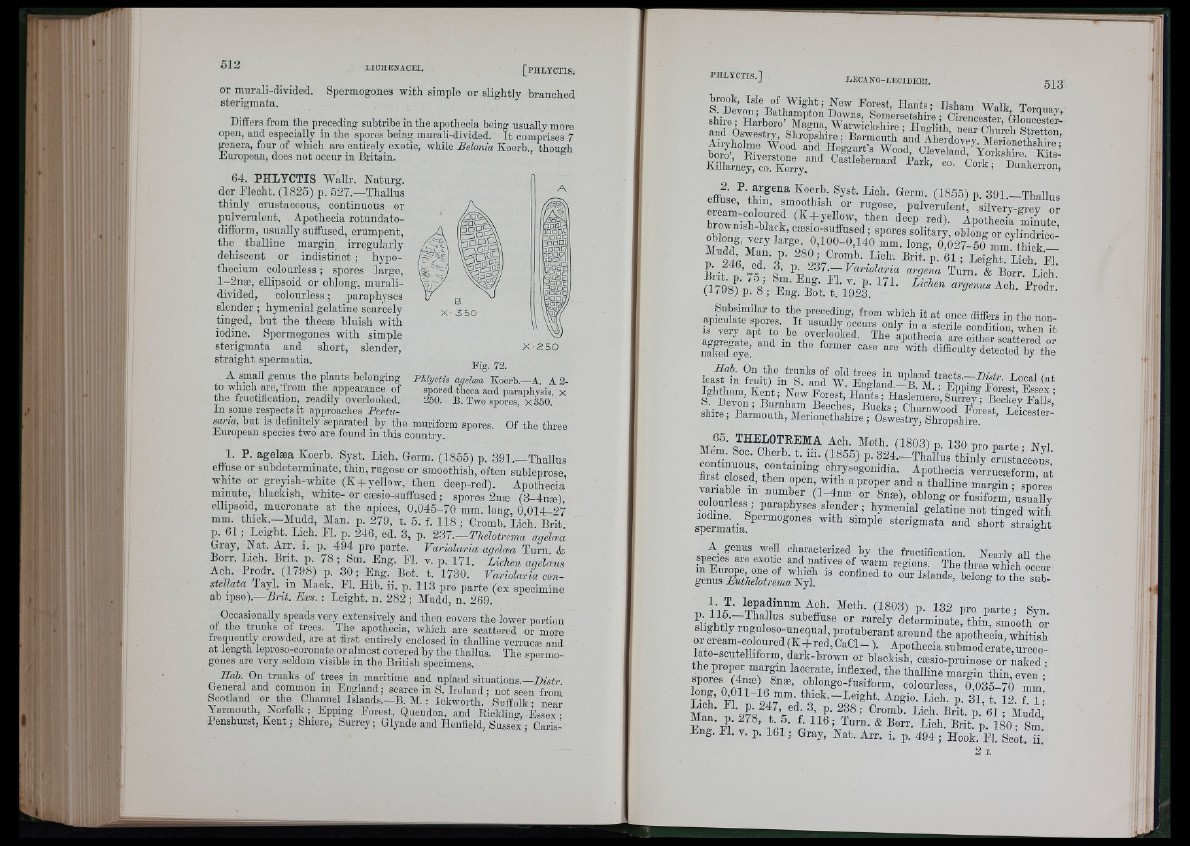
512
LICHENACEI, [PHLTCIlS
or murali-divided.
Spermogones w ith simple or slightly branched
sterigmata.
Differs from tbe preceding subtribe in the apothecia being usually more
open, and especially in the spores being murali-divided. I t comprises 7
genera, four of which are entirely exotic, while Belonia Koerb., though
European, does not occur in Britain.
64. PHLYCTIS Wallr. Naturg.
der Eleobt. (1825) p. 527.—Thallus
thinl)' crustaceous, continuous or
pulverulent. Apotheoia rotundato-
difform, usually suffused, erumpent,
th e tballine margin irregularly
dehiscent or in d istinct ; bypo-
theoium colourless ; sporos large,
l-2 n æ , ellipsoid or oblong, murali-
divided, colourless ; paraphyses
slender ; hymenial gelatine scarcely
tinged, b u t th e thecæ bluish w itb
iodine. Spermogones w itb simple
sterigmata and short, slender,
X - 2 5 0
stra ig h t spermatia.
Fig. 72.
A small genus tbe plants belonging
Phlyctis agelæa Koerb.—A. A 2-
to which are, 'from the appearance of
spored theoa and paraphysis, X
tbe fructiiicatiouj readily overlooked.
250. B. Two spores, X350.
In some respects it approaches Pertusaria,
but is definitely separated by the muriform spores.
Of the three
European species two are found in this country.
1. P. agelæa Koerb. Syst. Lioh. Germ. (1855) p. 391.—Tballus
effuse or subdeterminate, thin, rugose or smoothish, often suhleprose
white or greyisb-wbite (K + yellow, tb en deep-red). Apotheoia
minute, blackish, w h ite -o r cæsio-suffused ; spores 2næ (3 -4 næ)
ellipsoid, mucronate a t th e apices, 0 ,0 4 5 -7 0 mm. long 0 0 1 4 -2 7
mm. tb ic k .-M u d d , Man. p. 279, t. 5. f. 118 ; Cromb. Li?b. Brit
p. 61 ; Lerght. Lich. Fl. p. 246, ed. 3, p. 2 3 7— Thelotrema aqeloea
Gray, Nat. Arr. i. p. 494 pro parte. Variolaria agelæa Turn. &
Borr. te c h BriL J 78 ; Sm. Eng. El. v. p. 171. Lichen ageloeus
Aob. Prodr. (1798) p. 3 0 ; Eng. Bot. t. 1730. Variolaria con-
std la ta l a jL in Mack. Fl. Hib. ii. p. 113 pro p a rte (ex specimine
ab ipso).—H n i. Exs. : Leight. n. 282 ; Mudd, n. 269.
Occasionally speads very exten.sively and then covers the lower portion
J the trunks of trees. The apothecia, which are scattered or more
frequently crowded, are at first entirely enclosed in thalline verrucæ and
a t length leproso-coronate or almost covered by the thallus. The spermogones
are very seldom visible in the British specimens.
Hab. On trunks of trees in maritime and upland situations —Histr
General and common m England; scarce in S. Ireland ; not seen from
J o t l a n d or the Channel Islan d s.-B . M. ; Ickworth, Suffolk; near
Yarmouth, Norfolk ;_Eppmg Forest, Queudon, and Kidding, Essex-
Penshurst, Ken t; Shiere, Surrey; Glynde and Henfield, Sussex ; Carls?
PH L ÏC IIS .] LEOANO-LECIDEEI. 5 1 3
P i « « «
P. J g e n a Koerb. Syst. Lioh. Germ. (1855) p 3 9 1 Thallus
e ffu s j tb in , smoothish or rugose, pulverulent: ¿ i t e r y - g r e y òr
b iÒ Z - b t o Z + tfren deep red). Apotheoia minute
brownnh-black, oæsio-suffused; spores solitary, oblong or oylindrico’
i S S i S l l i g E
jn tin u o u s , containing ohrysogonidia. Apothecia verrucæform at
b rst closed, then open, w ith a proper and a th allin e margin • suo’res
variable in number ( l- 4 n æ or 8næ), oblong or f u s S ’u s S
co] j r l e s s ; paraphyses sle J e r ; hymenial gelatine n o t tinned w ith
sp e rZ atia sterigmata and sh o rt stra ig h t
s p Z f r e Z Ò S n S Ò f Z i Z “ ® 1 C t b r ò ^ ^ ^ ^
¿ e n liò T f r lÒ Z L t/ " " ‘-In lan d s , belong to the subp
n s ’ '“ P- 132 pro p a r te : Syn.
d i i t H r i S d o ” f r o ’y determinate, tbin, smooth or
slif,btly ruguloso-unequal, p rotuberant around the apotbecia whitish
Apotbecia submoderateTurcÒlato
scntelblorm, dark-brown or blackisb, cæsio-pruinose or !iaked •
th e proper margin lacerate, inflexed, th e thalline margin th in even ■’
i r r o o t r o io 3 r -7 ô z :
-p. Him. th ic k ,—Leight. Angio. Lich. n 31 t 12 f i •
E n Ò 'F l I 1 ¿ 1 r Z V En g . F l. v. p. 1 6 1 ; Gray, Nat. Al r r*. i. p. 4 9 4 ; H^onotk. .p F. l1. 8S0c;o t.S mii..
2 L